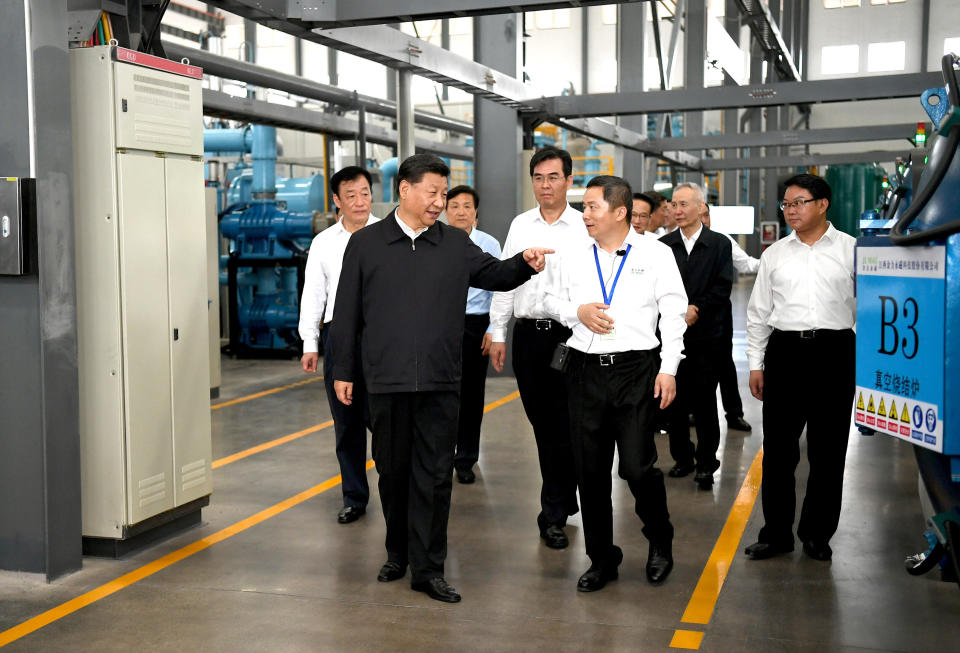U.S. mine aims to loosen China's grip on rare earth materials
All the talk of China’s grip on rare earth minerals is starting to resemble 2010: Beijing’s threats to weaponize its stronghold on these 17 metals, the global panic over a potential shortage, even the soul searching about how we got here in the first place.
“A lot of users of materials then said, we want outside China sources because we have to rid ourselves of this control and this problem,” says Jon Blumenthal, president and CEO of metals manufacturer Blue Line Corp. “Here we are, nine years later. We’re no better.”
Beijing’s target back then wasn’t the U.S. but Japan. Caught in a political tussle over disputed islands in the East China Sea, China cut off rare earth exports in retaliation, sending prices soaring. Japan vowed to become more independent, offering developmental loans to Australian mining giant Lynas Corporation as it built out its supply chains outside of China.
That cooperation shaved 10% off of China’s global market share.
But their American counterparts have done little to move the needle, with 80% of the country’s rare earth supply imported from China, according to USGS figures.
Blue Line Corp is among the U.S.-based companies aiming to change this. This week, Blue Line signed a memorandum of understanding with Lynas Corporation to build a rare earth processing facility in the U.S., a buildout that he says will take years.

Fears of a rare earth shortage prompted Molycorp Inc. to reopen America’s only rare earth mine in Mountain Pass, California, back in 2010. That same year, the company listed on the New York Stock Exchange for $14 a share. But a price collapse and poor investment decisions ultimately led to its demise, and It filed for bankruptcy five years later.
“There was this promise of all these things in the future, they got lucky with the price spike, they took advantage of it with deals and stock sales and whatnot, and it all collapsed,” says James Litinsky, co-chair of MP Materials, current owner of the Mountain Pass mine.
How we got here
Mountain Pass controlled the world’s rare earth supply for decades. But Blumenthal says a confluence of factors emerged around the mid-1980s, with growing concerns about the operation’s environmental effects, operating costs, and impact to workers. That was accompanied by restrictive regulations on thorium, a radioactive byproduct of the mining process.
“It is a labor intensive, capital intensive, complicated process,” Blumenthal said, referring to the process of separating out individual metals. “It can be very dangerous work, where plant workers can be hurt, killed making these materials. So, that is a very dangerous part of the supply chain.”
The slowdown coincided with China’s aggressive move to capture global market share through government subsidies, lax environmental standards, and lower labor costs, according to Litinsky. By 2010, China accounted for 97% of global rare earth supply.
“It’s very hard to look at this as a global economy, when you have one country that’s trying to take care of its environment and its workers, and another country that prioritizes growing their economy,” says Blumenthal. “It’s very difficult to compete.”
What’s next
Trade tensions between the U.S. and China have amplified the need to boost rare earth output domestically.
MP Materials already extracts 50,000 tons of rare earth concentrate each year but still relies on China to process the materials, subjecting them to a 25% tariff Beijing has imposed as a result of the trade war. Litinsky says the facility is on track to begin the separation process on shore by next year, and forecasts output of 5,000 metric tons of neodymium and praseodymium or NdPr, the most commonly used rare earth elements, by 2021. That would amount to 10% of the global market, according to Litinsky.
Blue Line Corp’s Blumenthal says any expansion of capacity will be costly and timely. He estimates any new mine will cost at least a billion dollars, to develop over a 10 year span.
Government involvement
In December 2017, President Trump signed an executive order to begin the process of reducing U.S. reliance on China for critical materials, directing agencies to find new sources of output and streamline the leasing and permitting process.
But Litinsky says that declaration has yet to result in any concrete action from the White House or Congress.
“It seems that there’s a lot of political interest in the topic. The question is, ‘How will the political interest be translated into action?’ We’re still waiting on that,” he said.
In a sign of mounting concerns about China’s grip on the sector, a Pentagon spokesman said this week, the Defense Department had submitted a rare earth mineral report to Congress, seeking federal funds to boost onshore production.
The 17 metals are crucial for use in everything from jets to satellites.
Air Force Lieutenant Colonel Mike Andrews said the request was included in a Defense Production Act III rare earths minerals report, as part of a program that gives the president “broad authority to ensure the timely availability of essential domestic industrial resources to support national defense and homeland security requirements through the use of highly tailored economic incentives.”
Akiko Fujita is an anchor and reporter for Yahoo Finance. Follow her on Twitter at @AkikoFujita
More from Akiko:
'The ultimate insult': How U.S.-listed Chinese companies are gaming American investors'
Really bad business practice': U.S. security experts sound off on Huawei
U.S.-China showdown: Huawei has 'completely taken over' the Mobile World Congress
Follow Yahoo Finance on Twitter, Facebook, Instagram, Flipboard, LinkedIn, YouTube, and reddit.

 Yahoo Finance
Yahoo Finance 
